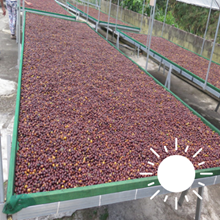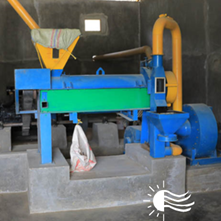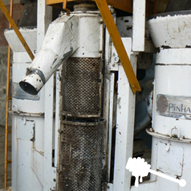You’ve probably noticed the icons on our Product Pages for the process used for our specialty coffees. But, have you ever wondered what we mean when we say our coffee is Washed, Semi-Washed, Natural, or Honey processed?
These processing methods are how the coffee farmers separate the coffee beans from the coffee fruit (or cherry). Although the geographic region does impact the type of process used to separate the bean from the pulp and outer fruit skin, it also greatly influences the taste, aroma, and overall value of the coffee. (Pretty cool, huh?)
Let’s take a look at each of these methods and what they bring to the coffee.

Natural: This is the traditional method for processing coffee and
can take up to 30 days. The cherries are hand-picked when ripe;
then spread out to dry with the fruit flesh (mucilage) still attached
to the green beans. (This process is also known as sun dried or dry
process and can offer complex flavors.)
The Natural method is quite labor-intensive because the cherries are
continuously monitored and turned to ensure they dry evenly
and do not over ferment.
Once dried, the coffee is moved to a dry mill where the fruit is removed and the green coffee is bagged for export.

Washed: This is the most commonly used process, developed as
producers sought better control and a more consistent flavor profile
for their finished product. In this method the coffee cherries are picked,
then pulped to remove the skin and fruit from the seeds, leaving only
the sticky mucilage layer firmly attached to the seed/bean.
Once pulped the coffee is fermented, which takes about 24-72 hours.
Then, the coffee is pushed through concrete channels using water.
The friction of contact with other beans and the channel surfaces washes
the flesh of the fruit away leaving the green beans in their white
parchment covers.
Although coffee afficionados may be divided about the value of this processing method, the natural process definitely adds sweetness and fruitiness to the coffee, regardless of variety or region.
The washed coffee beans are dried in the same manner used for Natural processing. After drying, the beans go to the dry mill and are bagged for export. (Because this process is water intensive, it does not work in places where water is scarce.)
Washed coffees tend to have a bright, acidic flavor and can produce a complex, clean cup of coffee that is highly appreciated by baristas. Many of our popular coffees are processed using this method.
Try our seasonal Papua New Guinea coffee to enjoy a medium-light roast washed coffee.

Semi-Washed: This method is common in Brazil and Sumatra.
Semi-washed differs from washed because the coffee is de-pulped
but ferments overnight for just about 12 hours (vs. 24 hours for
washed). In Sumatra, the coffee is washed and delivered wet to the
drying mill, where it is processed down to its green state, removing
the parchment layer while still at 40%-50% moisture. At this stage,
the beans are still fairly delicate, so their cell walls are ruptured
while the parchment is removed. This leads to rapid moisture loss
and a dramatic decrease in the time to dry vs. washed coffees. This
aspect of the process produces coffees that have lower acidity.
Try our Antheia Blend coffee to enjoy a light roast semi-washed coffee.

Honey: Despite its name, there is no honey involved! Commonly
used in Central America, this involves mechanically de-pulping the
coffee cherries so that a specific amount of flesh is left on the
beans. Honey processed coffee is frequently referred to with colors:
black, red, yellow, and white honey (representing the amount of
fruit flesh left on the bean after de-pulping) and affects the taste of
the finished coffee. Black honey means only the skin was removed,
leaving the rest of the fruit; white means nearly all the fruit was
removed.
After de-pulping the beans are dried (as in Natural processing),
being monitored and turned based on the amount of flesh left on
the beans. This allows the coffee bean to take on some of the fruit’s
flavor.
After it’s dried, the coffee is washed and dried again before being taken to the dry mill and bagged for export.
Honey processed coffees yield the body and flavor of natural coffees with the clarity and brightness of washed coffees.
Whatever processing method our growing partners use for their beans, you can be confident Public Domain coffees are roasted to bring out the flavor profiles unique to each region – for a coffee drinking experience you’ll truly appreciate.


